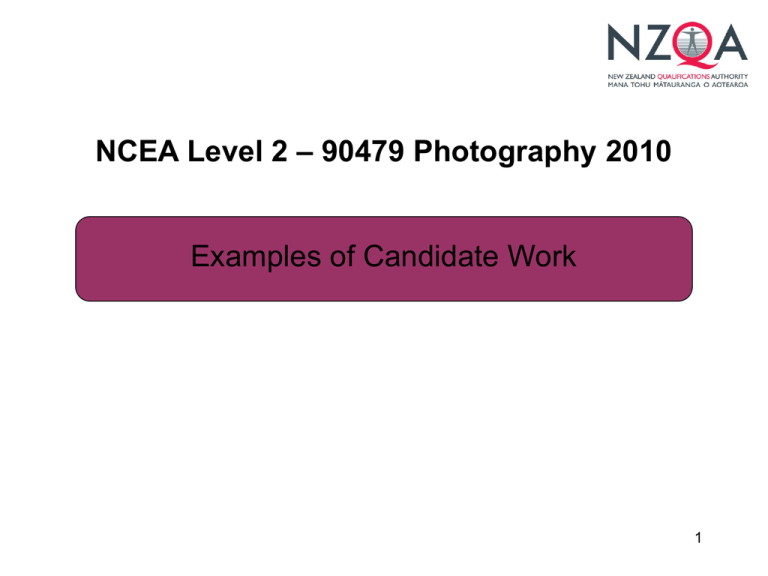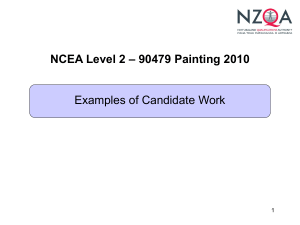NCEA Level 2 - Photography 2010 Exemplars
advertisement

NCEA Level 2 – 90479 Photography 2010 Examples of Candidate Work 1 Excellence 2 3 This submission was verified at the highest end of the Excellence grade range. This portfolio presents evidence beyond the requirements of The New Zealand Curriculum, Learning Media, Ministry of Education, 2007, and relates to the following strands in Visual Arts, Level 7: Understanding the Arts in Context; Developing Practical Knowledge; Developing Ideas; Communicating and Interpreting. This submission presents a dense exploration of an extensive range of ideas. These ideas have been clarified explicitly with clear intent and coherency. The narrative consists of a simple subject which has been combined with still life, where each composition has been considered in the introduction of a new idea. The candidate demonstrates extensive generation, analysis and regeneration of inventive ideas that provide a clear investigation of the initial proposal. Cleverly constructed sequencing combines photography with drawings, showing small developments building towards very successful images which clarify each idea. The use of a strong and systematic approach continues throughout the submission, where each image can be both read individually and linked pictorially to the next, culminating in three very successful images at the end of panel two. The candidate demonstrates a high level of facility and fluency in using processes, procedures, materials and techniques, using contemporary practice as a starting point with clear purpose and sophistication to develop their own ideas and a personal style. The use of digital media shows purpose and confidence and is combined with other picture-making techniques which are particularly relevant to the subject matter. A wide range of appropriate artist models such as Kenneth Josephson and Anna and Bernhard Blume have been implicitly used with intelligence throughout the submission. This, along with a focus on formal photographic elements such as scale, colour and framing, has resulted in a submission that surpasses what might be expected at an Excellence grade. 4 5 6 7 This submission was verified at the Excellence grade range. This portfolio presents outstanding evidence to meet requirements of The New Zealand Curriculum, Learning Media, Ministry of Education, 2007, and relates to the following strands in Visual Arts, Level 7: Understanding the Arts in Context; Developing Practical Knowledge; Developing Ideas; Communicating and Interpreting. This submission begins generating ideas using a documentary approach surveying a rural environment. Studies of landscape are followed by a sense of interior/exterior views. The candidate investigates formal properties of line, texture, space and shape. There is a conscious use of perspective showing contrast between flat and recessive surfaces. The candidate has demonstrated facility in the use of processes, procedures, materials and techniques, beginning with a study of depth of field and a range of formatting options before moving closer to examine framing and interior/ exterior views. Lighting has successfully been used to create silhouettes, which create contrast between busy and quiet areas. Digital manipulation has been used in Photoshop and traditional collage has been added, once the image has been printed. A regeneration of ideas is evident in the way collage is used purposefully linking back to the theme of decay. Space has been successfully fragmented and strong angles have been used to create depth. Glass acts as a filter and relates to the layering of surfaces. The candidate makes possible references to a range of artist models including, Marti Friedlander, Ann Shelton, Walker Evans, Robert Frank, and Lilo Raymond. This is done with purpose and understanding. 8 9 10 11 This submission was verified at the lower end of the Excellence grade range. This portfolio presents outstanding evidence to meet requirements of The New Zealand Curriculum, Learning Media, Ministry of Education, 2007, and relates to the following strands in Visual Arts, Level 7: Understanding the Arts in Context; Developing Practical Knowledge; Developing Ideas; Communicating and Interpreting. The candidate has developed a strong narrative proposition which has been told in both first and third person, using a variety of viewpoints. These viewpoints effectively place the viewer in the position of both protagonist and voyeur. Light is a central theme which is appropriate given the genre. The florescent lighting and strong architectural lines, combined with the intelligent use of colour, ensures the submission remains cohesive. The submission concludes confidently with an extremely strong final image. The candidate demonstrates facility in the use of processes, procedures, materials and techniques in the use of sequencing devices and monochromatic images. Colour has been restricted and used sensitively given the proposition set up on panel one. Atmosphere has been created through strong directional lighting which evolves subtly, using a restrained palette. The candidate has made possible references to Gregory Crewsdon, George Segal and Ralph Gibson implicitly throughout the submission, as well as a wide range of contemporary ‘urban’ photographers. For this submsission to sit more comfortably within the Excellence grade range, the candidate would need to consider regenerating a depth of ideas from panel one into panel two and consider presenting more than a single domineering image at the end of panel two. 12 13 14 Merit 15 16 This submission was verified at the higher end of the Merit grade range. This portfolio presents sound evidence to meet requirements of The New Zealand Curriculum, Learning Media, Ministry of Education, 2007, and relates to the following strands in Visual Arts, Level 7: Understanding the Arts in Context; Developing Practical Knowledge; Developing Ideas; Communicating and Interpreting. Initial ideas have been generated in the manner of a narrative told through a ‘Surrealist’ constructed reality. The initial idea has been approached with a sense of anticipation and fun from the opening photograph. The submission is presented in a linear manner, making small shifts which firmly hold it in the higher Merit grade range. At this level it is common to see the straight frame-by-frame development of narrative. The candidate demonstrates a high level of skill with processes, procedures, materials and techniques. This is evident in the controlled use of digital manipulation and colour. The candidate has used a restrained approach which has enhanced the work, rather than detracted from it. This ‘less is more’ approach demonstrates an understanding of the established practice investigated; e.g. Duane Michals. For this submission to move into the Excellence range, the candidate would need to investigate more divergent ideas allowing the outcome to be less determined, as in panel two where only small shifts have been made to advance the story. However, in this case, the student has resolved the narrative in an innovative and surprising way despite the linear structure. 17 18 19 20 This submission was verified at the lower end of the Merit grade range. This portfolio presents sound evidence to meet requirements of The New Zealand Curriculum, Learning Media, Ministry of Education, 2007, and relates to the following strands in Visual Arts, Level 7: Understanding the Arts in Context; Developing Practical Knowledge; Developing Ideas; Communicating and Interpreting. Initial ideas have been generated in a narrative, established through the use of a dreamscape sequence. An understanding of processes, procedures, materials and techniques is demonstrated in the selective use of colour to highlight this. The candidate demonstrates an understanding of a narrative approach by using a systematic layout to sequence their ideas. Clear links are made from one idea to another, although these shifts are small. Although ideas have been extended using the silhouette as a pictorial device, this candidate may have been able to take more risks in the progression of ideas if more options were presented early on panel one. The candidate begins to demonstrate some understanding of established practice, seen in the references made to Duane Michals and Megan Jenkinson. For this submission to sit more comfortably in the Merit grade range, the candidate would need to consider the sizing and layout of images in order to avoid repetition, which may confuse the reading of the panels. The candidate would also need to demonstrate more consistent and convincing decision-making, avoiding relying too heavily on the narrative approach. This is evident in the final images on panel two, which reach a plateau and run out of options. 21 22 23 Achieved 24 25 This submission was verified as clearly within the Achieved grade range. This portfolio presents sufficient evidence to meet requirements of The New Zealand Curriculum, Learning Media, Ministry of Education, 2007, and relates to the following strands in Visual Arts, Level 7: Understanding the Arts in Context; Developing Practical Knowledge; Developing Ideas; Communicating and Interpreting. Initial ideas have been generated using imagery from the domestic environment, investigating ideas around reflection and framing. Formal pictorial elements of line, light, texture, pattern and interior/exterior space are systematically developed using framing as a compositional device. The move towards abstraction is evident on panel two. Appropriate control of processes, procedures, materials and techniques is demonstrated in the consistent use of compositional devices such as framing, cropping and the rule of thirds. Colour and sizing are used appropriately given the initial propostion set up on panel one. Viewpoints explore angles and lead toward informing a journey around reflection and extension of ideas. Good choices have been made around sequencing, which enhance the readability of both panels. References to established practice are implied within the small and predictable shifts made. For this submission to gain a Merit, the candidate would need to consider further exploration of the subject matter and/or theme, allowing more options and the possibility to extend beyond the safe parameters and formulaic properties studied. Referring to more artist models would allow the student to gain valuable insight into established practice and provide options for the extension of ideas. 26 27 28 29 This submission was verified at the lower end of the Achievement grade range. This portfolio presents sufficient evidence to meet requirements of The New Zealand Curriculum, Learning Media, Ministry of Education, 2007, and relates to the following strands in Visual Arts, Level 7: Understanding the Arts in Context; Developing Practical Knowledge; Developing Ideas; Communicating and Interpreting. This submission generates ideas from a solid proposition based on a still life tradition. The candidate records objects related to memory such as the necklace and found photographs, as well as the guitar and music pages. Images are derived from more than one viewpoint and are laid out in clear groups which relate to each other. A systmetic approach is evident in the use of framing, composition and focus. The candidate has shown a development of ideas in the successful juxtapositions that bring together fragments of objects in the split images at the top of panel two, with possible references to David Hockney and Cubist traditions. Further investigation into this established practice would have allowed for an extension of ideas. For this submission to sit more comfortably within the Achieved grade range, this candidate would need to demonstrate more consistent understanding in their control of the camera in order to avoid unwanted shadows, flash reflection and uneven exposures. A more informed use of Photoshop would reduce greyness and improve colour management. In particular, attention to the final image and a more considered use of focus and juxtaposition would have helped. Exposure to a greater range of models would have provided the candidate with more opportunity to extend ideas; e.g. Robert Frank, Mari Mahr. 30 31 32 Not Achieved 33 34 This submission was verified at the higher end of the Not Achieved grade range. This portfolio did not present sufficient evidence to meet requirements of The New Zealand Curriculum, Learning Media, Ministry of Education, 2007, and relates to the following strands in Visual Arts, Level 7: Understanding the Arts in Context; Developing Practical Knowledge; Developing Ideas; Communicating and Interpreting. This submission represents a typical type of portfolio at this level. The pictorial qualities/formal elements have been neglected in favour of a narrative or story approach. For this submission to gain Achievement, this candidate would need to consider using more than one photo shoot as a source of imagery. A broader pictorial proposition would have allowed for the initial idea to be developed further. Generating ideas beyond the grid technique may have also provided the student with more picture making options and opportunity to develop more than one idea. Demonstrating more consistent control of the camera while exploring more formal compositional elements such as focus, framing, and viewpoints would also enhance this submission, by showing control of photographic processes and techniques. Careful attention to the presentation of the submission would also have enhanced the opportunity for this candidate to meet the criteria. The grouping of images has been considered however, more attention to the sizing of images and the amount of space surrounding these, may have assisted in the sequencing of the pictorial proposition. Ensuring images systematically progress from panel one to panel two also enables the ideas to be read more easily. Exposure to explicit and/or implicit artist models would have provided more opportunities for the candidate to broaden their journey and thus create sufficient generation and development of ideas. 35 36 37







